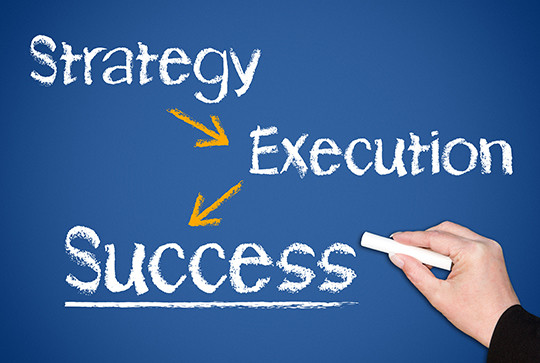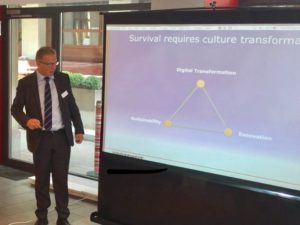Building the Bridge to embrace Digital Transformation – Employees first!
- posted in Benefits Realization, Business Transformation, Change Management, Digital Transformation
- / with 0 comments

Start early with Change Management to empower the employees for new ways of thinking to achieve your ROI by creating a Change Agent Network from the outset, inviting the Change Agents to co-create the Strategic Alignment Framework, jointly with the Board and the Executive Management Team.
Digital Transformation is multi-faceted, requiring disruptive, new ways of working & the ability to quickly adapt business models, enabled by an inclusive leadership
Culture Transformation – essential for success
According to the State of the Global Workplace (Gallup 2017), only 15% of the worldwide workforce is motivated and engaged in regards to their work. At the same time, as per Forbes and Gartner, only about 50% of current companies will continue to exist beyond 2020, due to Digital Transformation with the needed competence shift and disruptive new ways of working, the Talent Management issue, accelerated globalisation and more. These factors will require new, disruptive approaches and ways of working, including the elimination of silos. Hence success requires culture transformation, which takes time. It’s all about for companies to become organisational agile, starting by leading with the culture. The Core Values needs to be the driver for everything we do, providing guidance for behaviours that transform the culture.
Empower the employees for innovative ways of thinking
I am sharing with you a Client Success Story.
Challenges of Digital Transformation
One of the main challenges related to change and transformation is to anchor a common and clear sense of direction. The most common reason why the process is not working is that the board and management team do not have the same agenda for the strategic focus, both within and between these functions.
The Big Picture – Client Success Story

6 steps to successfully implement Digital Culture Transformation
- Strategy Alignment Framework – The C-Level, CEO and/or Board Members need to agree on a common and joint direction for the Digital Transformation
- Set Up the Digital Transformation | Prepare the Change with the employees
- Define the Change Management Strategy and develop Change Management plans
- Bridge the Gap between Strategy and Execution
- Prioritise – Less is more – Select three big rocks to be work with, every 90 days
- Integrate Change Management and Digital Transformation Programme
Watch the full story:
The outcome was a change-ready organisation with highly developed Awareness and Desire for its Digital Transformation.
Key Success Factors for the setup of this Digital Transformation Journey
- Start early with Change Management to empower the employees for new ways of thinking to achieve your ROI by creating a Change Agent Network from the outset, inviting the Change Agents to co-create the Strategic Alignment Framework. It’s important to engage the entire organisation at the beginning of the change journey, to create awareness for the change, thereby anticipating resistance and accelerating adaption rate of new behaviours & changed Ways of Working.
- Defining the Change Management Strategy, directly after the completion of the Strategic Alignment Framework.
- Create engagement in the organisation by raising Awareness and Desire for the Transformation Journey.
- Integrate Change Management into your transformation journey/programme.
Digital Transformation is an intensively discussed topic but there is a misconception in the thinking and approach; Digital Transformation is not about “digital”; it’s transforming the culture, to become highly innovative & organisational agile, being able to quickly adapt to new business models.
Digital Transformation also requires a fast competence shift: Already in 2020, AI will become a positive net job motivator, creating 2.3M jobs while only eliminating 1.8M jobs Gartner. By that time, more than 25% of the worldwide workforce will be made of Millenials and Generation Z individuals. They connect by deep-rooted values and purpose, they use technology to their advantage and they want an inclusive leadership, not being managed in silos.
Only 50% of current companies will continue to exist after 2020
How are your experiences from Digital Culture Transformation?
What are your learnings?
What is your key challenge?
Thanks for commenting below.
Book a 30 min call with Christian de Loës to explore your situation with tips where and how to get started.
#digitaltransformation #leadership #businessagility #businesstransformation
#transformations #employeesfirst #swissdigitalday #transformpeople
#ProsensitChange
Christian de Loës, the founder of Prosensit Change Management, is a Digital Business Transformation Leader & Strategist, Change Advisor/Agent and Speaker with 25+ years international leadership experience in Sales & Marketing, Portfolio-, Program- & Project Management and Change Management internationally. He is passionate about inspiring & advising mid-sized SME board members & executives, supporting them to bridge the gap between strategy & execution, including Change Management.


